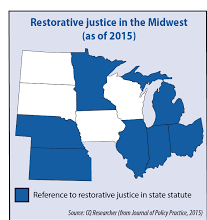Restorative Justice and the State Critical Essay 2 – Finding the Balance: Restorative Justice and the State – Drawing on the different principles and theories of restorative justice that we have examined – values, processes, relationships, emotional dynamics, healing and community building – develop a rational for the place for restorative justice within a State based justice system.

Restorative Justice and the State Critical Essay Questions
As you write consider the following questions:
How do you define restorative justice? Who participates in restorative justice? What are the emotional dynamics of restorative justice? Why are emotions important in bringing justice home? How does restorative justice strengthen our justice system? What is the relationship between restorative justice and the rule of law? What are the limits and challenges of restorative justice? How do these strengths, limits and challenges compliment the strengths, limits and challenges of the retributive system? Why does our justice system need to be trauma informed? What is the role of community?
Restorative Justice and the State Critical Essay Required Readings
Braithwaite, J. (2002). Setting Standards for Restorative Justice. British Journal of Criminology, 42(3), 563-577.
Braithwaite, V., Huang, H., & Reinhart, M. (2013). ‘Love thy neighbour’ values, needs and willingness to participate in restorative justice: A survey of Australian and Japanese victims and offenders. Restorative Justice: An International Journal 1(1), 91-121.
Llewellyn, J. J., Archibald, B. P., Clairmont, D., & Crocker, D. (2013). Imagining success for a restorative approach to justice: Implications for measurement and evaluation. Dalhousie Law Journal, 36(2), 281-316.
Luzon, G. (2016) Restorative justice and normative responsibility, Restorative Justice, 4:1, 27-40, DOI: 10.1080/20504721.2016.1149377
Braithwaite, J. (2000). Shame and Criminal Justice. Canadian Journal of Criminology, 42(3), 281-298.
Harris, N., Walgrave, L., & Braithwaite, J. (2004). Emotional Dynamics in Restorative Conferences. Theoretical Criminology, 8(2), 191–210. https://doi.org/10.1177/1362480604042243
http://www.inquiriesjournal.com/articles/1401/shame-anger-and-guilt-the-hierarchy-of-emotions-in-restorative-justice DuFour, S. N. (2016).
Sherman, L. (2003). Reason for Emotion: Reinventing Justice with Theories, Innovations and Research. The American Society of Criminology 2002 Presidential Address. Criminology, 41, 1-38.
Randall, M. & Haskell, L (2013). Trauma-Informed Approaches to Law: Why Restorative Justice Must Understand Trauma and Psychological Coping. Dalhousie Law Journal. 36(2), 501-533.
Elmar G. M. Weitekamp & Stephan Parmentier (2016) Restorative justice as healing justice: looking back to the future of the concept, Restorative Justice, 4:2, 141-147,
Van Camp, T. (2016) The role of community in restorative justice, Restorative Justice, 4:3, 435-438
Boyes-Watson, C. & Pranis, K. (2012). Science Cannot Fix This: The Limitations of Evidence-Based Practice. Contemporary Justice Review, 15(3), 265-275.




